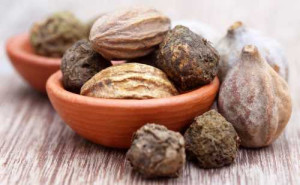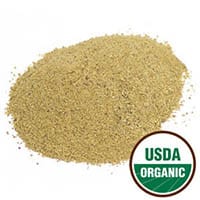Triphala Superfood
NEWS: This superfood is now available in the SANEStore as a convenient whole-food powder so you can more easily enjoy it in smoothies and recipes.

Raw Organic non-GMO Triphala (“three fruits”), an herbal formulation originating in India, has been found to act as a complete body cleanser. Not only does Triphala help to detoxify and cleanse the colon, it also purifies the blood and removes toxins from the liver. Other cleansing benefits of Triphala include reducing cholesterol (serum cholesterol) and helping reduce high blood pressure.
Triphala is made from the fruits of three trees that grow in India and the Middle East (Sanskrit term triphala literally means three fruits). The fruits are dried, ground into powder, and blended in a precise manner developed by the ancient Ayurvedic herbalists. The three herbs that comprise triphala have potent healing properties:
Amalaki (Amla, Indian gooseberry, emblica officinalis) is considered one of the best rejuvenating herbs in Ayurveda. It’s a strong natural antioxidant containing 20 times more vitamin C than orange juice. In India, amalaki is known as the nurse herb because it strengthens the immune system and cools the body.
Haritaki (Harada, terminalia chebula) has the strongest laxative powers of the three fruits contained in triphala. In Tibet, haritaki is so highly revered that in their sacred paintings, it’s often depicted in the extended palm of the medicine Buddha. The herb also has astringent properties.
Bibhitaki (Behada, terminalia belerica) is an excellent rejuvenative with both laxative and astringent properties. It eliminates excess mucous in the body and provides support for a variety of lung conditions, including bronchitis and asthma.
Triphala gently cleanses and detoxifies the body without irritating the colon. In addition, unlike other laxatives that deplete the body, triphala actually strengthens and nourishes the bones, nervous system, and reproductive organs. In recent years, a number of research studies have found new uses for this herb, including reducing mutated cellular growth. It is also found to have high antioxidant qualities, and is even useful for noise and stress induced conditions.
Triphala is taken as a general health tonic, useful for all body types and a variety of conditions. It is commonly recommended to tone and strengthen the digestive system, particularly in cases of weak digestion and constipation. Triphala is a gentle laxative that can be used daily and is not habit-forming, and has no adverse effects on the intestinal flora (the microorganisms that aid digestion). It is said to improve the function of the stomach and intestines, and is also useful for cases of excess stomach acid. Triphala regulates and detoxifies the bowels, improves overall health by increasing the efficiency and absorption of digestion, and reduces gas. It has a balancing effect on the body’s metabolism, and is prescribed to restore appetite. The herbal compound also helps the body to eliminate excess fat, by improving metabolism. Because of its gentle properties, triphala is recommended as a digestive aid for the elderly and for those with sensitive stomachs.
In addition to restoring the balance of the digestive tract, triphala is used as a blood builder and purifier, and may increase red blood cell count and hemoglobin levels. Because of its balancing effect on blood sugar levels it may be useful for those with diabetes and hypoglycemia. It also has anti-cholesterol and anti-mucus properties in the body. Triphala is believed to strengthen the kidneys and liver, and can be helpful for hepatitis sufferers.
Raw Triphala has a strong taste. It is recommended to drink it with juice or to place honey on the tongue before swallowing. It is often possible to find Triphala in pill form however, the powdered form is much more effective and can be mixed thoroughly in a small amount of cold or warm water or simmered in water and drunk as a medicinal tea. When used as a digestive tonic or laxative, it is best taken in the evening, about two hours after eating, and at least 30 minutes before bedtime. No food should be eaten for one and a half hours after ingestion.
Why Try Triphala Superfood?
- Feeling pure, light & revitalized
- Supports the body’s natural detoxification process
- Supports a healthy inflammation response
- Nourishing your nervous system, blood & muscle
- Nourishing the Adrenals
- Nourishing the bones, nervous system, & reproductive organs
- Supporting immune system
- Eliminating excess mucous
- Astringent properties
- Supporting a healthy mental outlook
- Laxative properties
- Traditionally known as a great rejuvenator & antioxidant
- Supporting healthy digestion, assimilation & elimination
- Supporting a healthy respiratory system
- Supporting healthy metabolism
References
1. Ayurvedic pharmacopoeia committee. The Ayurvedic Formulary of India, Part I, 2nd English ed. New Delhi: Controller of Publications; 2003
2. Anne McIntyre (7 September 2005). Herbal treatment of children: Western and Ayurvedic perspectives. Elsevier Health Sciences. pp. 278–. ISBN 9780750651745. Retrieved 24 July 2010.
3. Juss SS. Triphala – the wonder drug. Indian Med Gaz 1997;131:94-6.
4. Nadkarni AK. Indian Materia Medica. 3rd ed. Mumbai: Popular Press; 1976. p. 1308-15.
5. Harbans Singh Puri (2003). Rasayana: ayurvedic herbs for longevity and rejuvenation. CRC Press. pp. 30–. ISBN 9780415284899. Retrieved 24 July 2010.
6. Jagetia, GC; Baliga, MS; Malagi, KJ; Sethukumar Kamath, M (Mar 2002). “The evaluation of the radioprotective effect of Triphala (an ayurvedic rejuvenating drug) in the mice exposed to gamma-radiation.”. Phytomedicine : international journal of phytotherapy and phytopharmacology 9 (2): 99–108. PMID 11995956.
7. Reddy TC, Aparoy P, Babu NK, Kalangi SK, Reddanna P (May 2010). “Kinetics and Docking Studies of a COX-2 Inhibitor Isolated from Terminalia bellerica Fruits”. Protein Pept Lett 17 (10): 1251–7. PMID 20441561.
8. Pawar V, Lahorkar P, Anantha Narayana DB. Development of a RP-HPLC method for analysis of Triphala curna and its applicability to test variations in Triphala curna preparations. Indian J Pharm Sci [serial online] 2009 [cited 2010 Aug 1];71:382-6. Available from:http://www.ijpsonline.com/text.asp?2009/71/4/382/57286
9. Mahesh R, Bhuvana S, Begum VM (August 2009). “Effect of Terminalia chebula aqueous extract on oxidative stress and antioxidant status in the liver and kidney of young and aged rats”. Cell Biochem. Funct. 27 (6): 358–63. doi:10.1002/cbf.1581. PMID 19548245.
10. Sandhya T, Lathika KM, Pandey BN, et al. (October 2006). “Protection against radiation oxidative damage in mice by Triphala”. Mutat. Res. 609 (1): 17–25. doi:10.1016/j.mrgentox.2006.05.006. PMID 16860592.
11. Srikumar R, Parthasarathy NJ, Manikandan S, Narayanan GS, Sheeladevi R (February 2006). “Effect of Triphala on oxidative stress and on cell-mediated immune response against noise stress in rats”. Mol. Cell. Biochem. 283 (1-2): 67–74. doi:10.1007/s11010-006-2271-0. PMID 16444587.
12. Phetkate, Pratya; Kummalue, Tanawan; U-pratya, Yaowalak; Kietinun, Somboon. “Significant Increase in Cytotoxic T Lymphocytes and Natural Killer Cells by Triphala: A Clinical Phase I Study”. Evidence-Based Complementary and Alternative Medicine 2012: 1–6. doi:10.1155/2012/239856.
13. Gupta, SureshKumar; Kalaiselvan, V; Srivastava, Sushma; Agrawal, ShyamS; Saxena, Rohit. “Evaluation of anticataract potential of Triphala in selenite-induced cataract: In vitro and in vivo studies”. Journal of Ayurveda and Integrative Medicine 1 (4): 280. doi:10.4103/0975-9476.74425.
14. Lu, Kai; Chakraborty, Debanjan; Sarkar, Chandrani; Lu, Tingting; Xie, Zhiliang; Liu, Zongfa; Basu, Sujit (24 August 2012). “Triphala and Its Active Constituent Chebulinic Acid Are Natural Inhibitors of Vascular Endothelial Growth Factor-A Mediated Angiogenesis”. PLOS one 7 (8): 7 Extra |pages= or |at= (help). doi:10.1371/journal.pone.0043934.
15. Jagetia GC, Malagi KJ, Baliga MS, Venkatesh P, Veruva RR. “Triphala, an ayurvedic rasayana drug, protects mice against radiation-induced lethality by free-radical scavenging.” Journal of Alternative and Complementary Medicine 2004 10(6):971-8.
16. Rasool M, Sabina EP. “Antiinflammatory effect of the Indian Ayurvedic herbal formulation Triphala on adjuvant-induced arthritis in mice.” Phytotherapy Research 2007 21(9):889-94.
17. Shi Y, Sahu RP, Srivastava SK. “Triphala inhibits both in vitro and in vivo xenograft growth of pancreatic tumor cells by inducing apoptosis.” BMC Cancer 2008 10;8:294.
18. Srikumar R, Jeya Parthasarathy N, Sheela Devi R. “Immunomodulatory activity of triphala on neutrophil functions.” Biological & Pharmaceutical Bulletin 2005 28(8):1398-403.
19. Kaur S; The in vitro antimutagenic activity of Triphala–an Indian herbal drug; Food Chem Toxicol; 2002 Apr; 40(4): 527-34.
20. Jagetia GC, et al; The evaluation of the radioprotective effect of Triphala (an ayurvedic rejuvenating drug) in mice exposed to gamma-radiation; Phytomedicine; 2002 Mar; 9(2): 99-108.
21. Thakur CP, et al; The Ayurvedic medicines Haritaki, Amala and Bahira reduce cholesterol-induced atherosclerosis in rabbits; J Ethnopharmacol; 1996 Nov; 54 (2-3): 119-24.
22. Malekzadeh F, et al; Antibacterial activity of black myrobalan (Terminalia chebula Retz) against Helicobacter pylori; Int J Cardiol; 1988 Nov; 21 (2):167-75.
23. Sohni, YR and Bhatt, RM; Activity of crude extract formulation in experimental hepatic amoebiasis and in immunomodulation studies; Journal of Ethno Pharmacol; Nov. 1996.
24. Biswas S, et al; Phytother Res; 1999 Sept; 13 (6): 513-6.
25. Jacob, A, et al; Eur J Clin Nutr; 1988 Nov; 42 (11): 939-44.
26. Mishra, M. et al; British Journal of Experimental Pathology; 1981 Oct; 62 (5): 526-8.
27. Mathur R, et al; Journ Ethno Pharmacol; 1996 Feb; 50 (2): 61
28. Jose JK, et al; Journ Ethno Pharmacol; 2000 Sept; 72 (1-2): 134-40.
29. Bhattacharya A, et al; Phytomedicine; 2000 April; 7 (2): 172-175.
30. Bhattacharya A, et al; Indian Journal of Experimental Biology; 1999 July; 37 (7): 676-80.
31. Scartezzinini P, et al; Journ Ethno Pharmacol; 2000 July; 71 (1-2): 23-43.
33. J Ethnopharmacol. 2013 Sep 16;149(2):490-8. doi: 10.1016/j.jep.2013.07.003. Epub 2013 Jul 10.
34. Constituents from Terminalia species increase PPARa and PPARy levels and stimulate glucose uptake without enhancing adipocyte differentiation.
35. J Surg Res. 2008 Jan;144(1):94-101. Epub 2007 Jul 27.Triphala promotes healing of infected full-thickness dermal wound.
36.J Surg Res. 2010 Jan;158(1):162-70. doi: 10.1016/j.jss.2008.07.006.Triphala incorporated collagen sponge–a smart biomaterial for infected dermal wound healing.
37. Daru. 2012 Sep 10;20(1):33. doi: 10.1186/2008-2231-20-33.Efficacy of ‘Itrifal Saghir’, a combination of three medicinal plants in the treatment of obesity; A randomized controlled trial.
38. J Ayurveda Integr Med. 2010 Oct;1(4):280-6. doi: 10.4103/0975-9476.74425.Evaluation of anticataract potential of Triphala in selenite-induced cataract: In vitro and in vivo studies.
39. Pole, Sebastian. Ayurvedic Medicine: The Principles of Traditional Practice. Churchill Livingston, 2006. 126-127, 145-146, 194-195.
40. G. H. Naik, et al. In vitro antioxidant studies and free radical reactions of triphala, an ayurvedic formulation and its constituents. Phytotherapy Research 2005; 19(7): 582-586.
41. Vani, T. et al. Antioxidant properties of the Ayurvedic formulation triphala and its constituents. Pharmaceutical Biology 1997; 35 (5): 313-317.
42. Shi Y, Sahu RP, Srivastava SK. Triphala inhibits both in vitro and in vivo xenograft growth of pancreatic tumor cells by inducing apoptosis. BMC Cancer. 2008 Oct 10; 8:294.
43. Thakur CP, Thakur B, Singh S, Sinha PK, Sinha SK. The Ayurvedic medicines Haritaki, Amala and Bahira reduce cholesterol- induced atherosclerosis in rabbits. Int J Cardiol 1988; 21: 167- 75.
44. Williamson, Elizabeth. Major Herbs of Ayurveda. Churchhill Livingston, 2002. 210-214, 294-297, 298-301.
45. http://www.naturalstandard.com/
46. Ihantola-Vormisto, A., Summanen, J., Kankaanranta, H., Vuorela, H., Asmawi, Z. M., and Moilanen, E. Anti-inflammatory activity of extracts from leaves of Phyllanthus emblica. Planta Med 1997;63(6):518-524
47. Jain, S. K. and Khurdiya, D. S. Vitamin C enrichment of fruit juice based ready-to-serve beverages through blending of Indian gooseberry (Emblica officinalis Gaertn.) juice. Plant Foods Hum.Nutr. 2004;59(2):63-66.
48. Scartezzini, P. and Speroni, E. Review on some plants of Indian traditional medicine with antioxidant activity. J Ethnopharmacol. 2000;71(1-2):23-43.
49. Dick, Michael. Some Words about Triphala.
50. Sharma, P. V. Caraka Samhita. Volume 4, Chikitsa-Sthana, 1.16-37.
51. Tierra, Michael. The Wonders of Triphala.
52. Scartezzini P, Antognoni F, Raggi MA, Poli F, Sabbioni C. Vitamin C content and antioxidant activity of the fruit and of the Ayurvedic preparation of Emblica officinalis Gaertn. J Ethnopharmacol. 2006;104(1-2):113-118.








